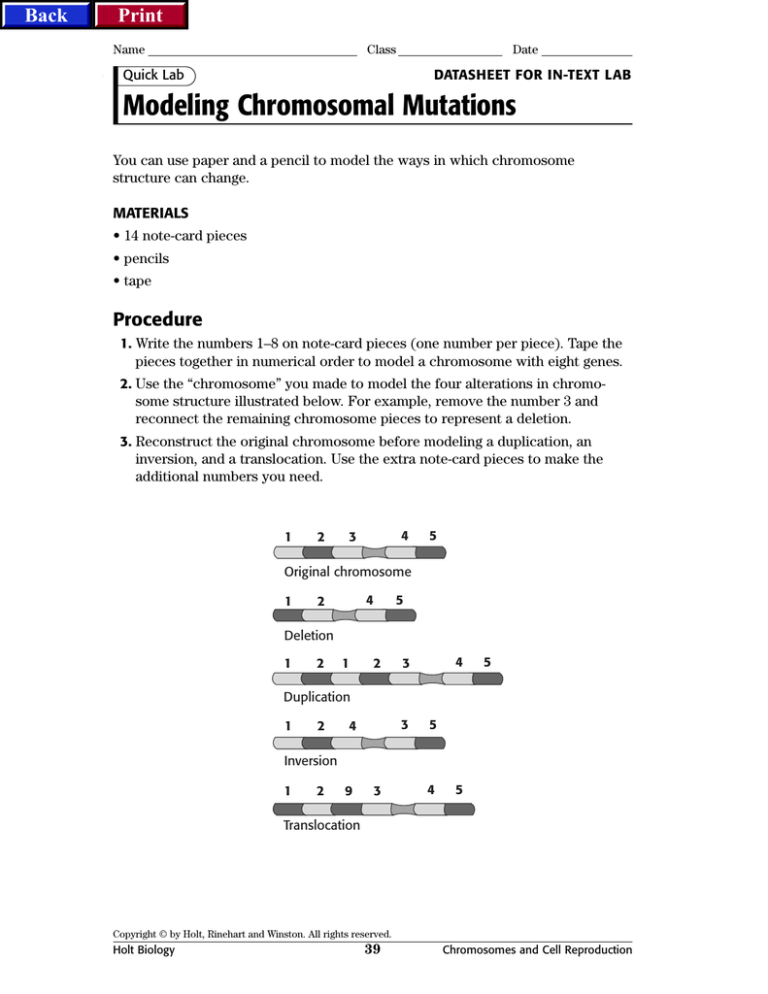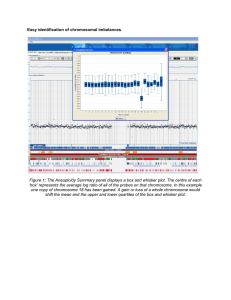
Back
Print
Name
Class
Date
Quick Lab
DATASHEET FOR IN-TEXT LAB
Modeling Chromosomal Mutations
You can use paper and a pencil to model the ways in which chromosome
structure can change.
MATERIALS
• 14 note-card pieces
• pencils
• tape
Procedure
1. Write the numbers 1–8 on note-card pieces (one number per piece). Tape the
pieces together in numerical order to model a chromosome with eight genes.
2. Use the “chromosome” you made to model the four alterations in chromosome structure illustrated below. For example, remove the number 3 and
reconnect the remaining chromosome pieces to represent a deletion.
3. Reconstruct the original chromosome before modeling a duplication, an
inversion, and a translocation. Use the extra note-card pieces to make the
additional numbers you need.
1
2
4
3
5
Original chromosome
1
4
2
5
Deletion
1
2
1
2
4
3
5
Duplication
1
2
3
4
5
Inversion
1
2
9
3
4
5
Translocation
Copyright © by Holt, Rinehart and Winston. All rights reserved.
Holt Biology
Program Title
39
Chromosomes and Cell Reproduction
Chapter Title
Back
Print
Name
Class
Date
Modeling Chromosomal Mutations continued
Analysis
Describe how a cell might be affected by each mutation if the cell were to
receive a chromosome with that mutation.
Copyright © by Holt, Rinehart and Winston. All rights reserved.
Holt Biology
Program Title
40
Chromosomes and Cell Reproduction
Chapter Title
Back
Print
TEACHER RESOURCE PAGE
Name
Class
Date
Quick Lab
DATASHEET FOR IN-TEXT LAB
Modeling Chromosomal Mutations
You can use paper and a pencil to model the ways in which chromosome
structure can change.
MATERIALS
• 14 note-card pieces
• pencils
• tape
Procedure
1. Write the numbers 1–8 on note-card pieces (one number per piece). Tape the
pieces together in numerical order to model a chromosome with eight genes.
2. Use the “chromosome” you made to model the four alterations in chromosome structure illustrated below. For example, remove the number 3 and
reconnect the remaining chromosome pieces to represent a deletion.
3. Reconstruct the original chromosome before modeling a duplication, an
inversion, and a translocation. Use the extra note-card pieces to make the
additional numbers you need.
1
2
4
3
5
Original chromosome
1
4
2
5
Deletion
1
2
1
2
4
3
5
Duplication
1
2
3
4
5
Inversion
1
2
9
3
4
5
Translocation
Copyright © by Holt, Rinehart and Winston. All rights reserved.
Holt Biology
Program Title
59
Chromosomes and Cell Reproduction
Chapter Title
Back
Print
TEACHER RESOURCE PAGE
Name
Class
Date
Modeling Chromosomal Mutations continued
Analysis
Describe how a cell might be affected by each mutation if the cell were to
receive a chromosome with that mutation.
Answers will vary based on the type of mutation: deletion: cell would be
missing a gene, which could prove fatal; duplication: cell would have an
extra gene, which could prove fatal or result in malfunctioning of the cell;
inversion: cell may not be able to use the gene because it is located in a
different area on the chromosome, which could prove fatal; translocation:
cell may not be able to use the gene because it is located on a different
chromosome, which could prove fatal.
Copyright © by Holt, Rinehart and Winston. All rights reserved.
Holt Biology
Program Title
60
Chromosomes and Cell Reproduction
Chapter Title


